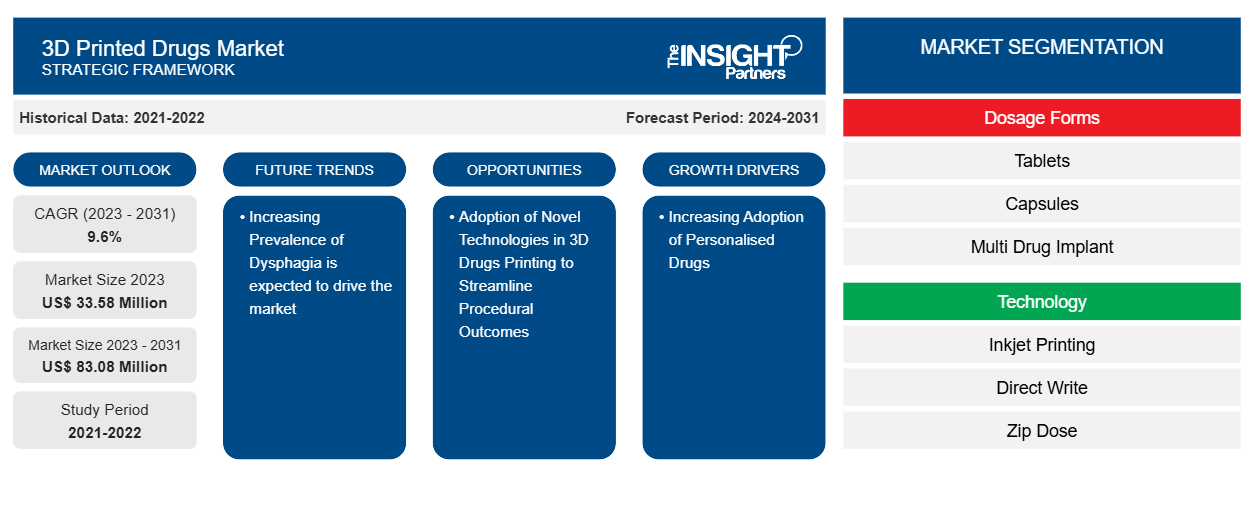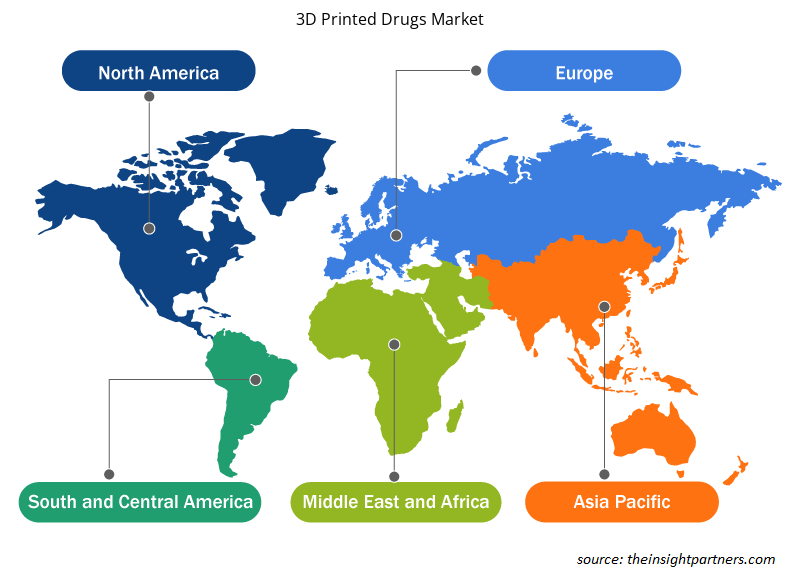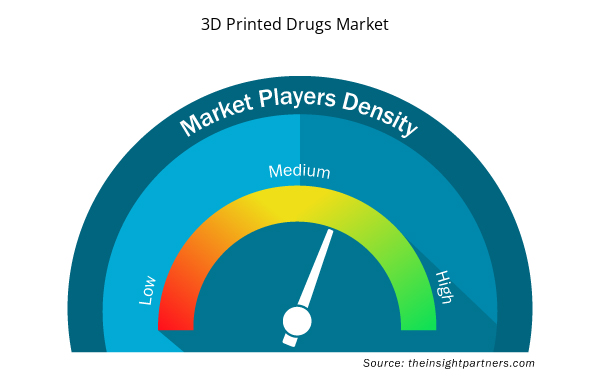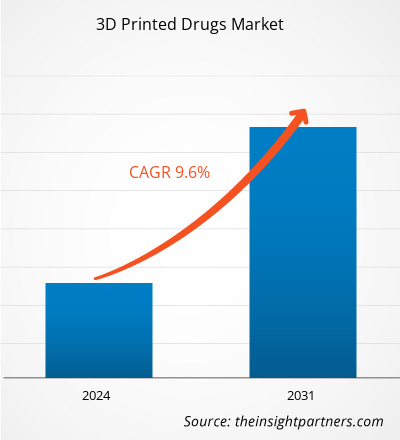The 3D Printed Drugs Market size is projected to reach US$ 83.08 million by 2031 from US$ 33.58 million in 2023. The market is expected to register a CAGR of 9.6% in 2023–2031. adoption of novel technologies in 3D drug printing to streamline procedural outcomes is likely to remain a key 3D printed drugs market trend.
3D Printed Drugs Market Analysis
A 3D printed drug is a pharmaceutical product manufactured using 3D printing technology, which creates a 3D solid from the digital file. 3D-printed drugs play a significant role in personalized medicine. The technology also assists in the study of tailored drug release profiles. It is referred to the digital file that contains information about the desired drug release profile for 3D-printed drugs. The profile contains the following information drug concentration, release rate and kinetics, time-dependent release profile, and material properties. This will help to develop personalized medicine with precise drug delivery, which leads to improved efficiency, enhanced patient compliance, and reduced side effects.
3D Printed Drugs Market Overview
3d printed drugs refer to pharmaceuticals initiated using 3D printing technology, which allows for the precise fabrication of complex structures and customized dosage. This approach offers various benefits like personalized medicine, complex geometries, rapid prototyping, on-demand production, and improved drug delivery. Spritam, ZipDose are some of the examples of 3D-printed drugs. The market's growth is ascribed to key driving factors, such as increasing awareness of 3D printing and extensively growing developments in 3D printing research. However, limited use due to illegal drug manufacturing is likely to show a negative impact on market growth during the forecast period.
Customize This Report To Suit Your Requirement
You will get customization on any report - free of charge - including parts of this report, or country-level analysis, Excel Data pack, as well as avail great offers and discounts for start-ups & universities
3D Printed Drugs Market: Strategic Insights

- Get Top Key Market Trends of this report.This FREE sample will include data analysis, ranging from market trends to estimates and forecasts.
Customize This Report To Suit Your Requirement
You will get customization on any report - free of charge - including parts of this report, or country-level analysis, Excel Data pack, as well as avail great offers and discounts for start-ups & universities
3D Printed Drugs Market: Strategic Insights

- Get Top Key Market Trends of this report.This FREE sample will include data analysis, ranging from market trends to estimates and forecasts.
3D Printed Drugs Market Drivers and Opportunities
Increasing Prevalence of Dysphagia to Favor Market
The worldwide population is mounting, such that it is predicted that there will be 2 billion over the age of 65 years by 2050; the most significant proportional increase will be in those over the age of 85 years. Various epidemiologic reports indicate that the prevalence of dysphagia is common in older populations and children. According to the statistics of the CDC, over 795,000 people are getting affected by strokes in the US every year, wherein 50% of stroke patients are associated with swallowing disorders. Additionally, various neurological diseases are known to be associated with dysphagia. The porous structure of 3D-printed drugs makes them collapse easily in the oral cavity. Thus, this form of medication is helpful for patients who often have swallowing difficulties, which in turn is driving the market's growth during the forecast period.
Emerging Market in Developing Countries
3D printing technologies are widely used in many areas, including fashion, construction, aerospace, and many other industries. In the field of medicine, it is being used mainly in dentistry and tissue engineering. However, the use of 3D printing technology in the pharmaceutical field is relatively recent. Many business sectors are unleashing the power of 3D printing technology, and experts predict that 3D printed (3DP) medications will revolutionize the pharmaceutical sectors during the forecast period. There’s a real opportunity with precision medicine to scale and dial in dose size for a specific patient. Many drug companies see tremendous opportunity and greater flexibility in creating dosage forms that meet specific patient needs. For instance, Cincinnati-based Aprecia is a pharmaceutical company specializing in 3DP medicinal products. In addition, in Feb 2020, Merck and AMCM, Starnberg, Germany, announced a cooperation agreement to deal with the 3D printing of tablets. Such activities are projected to offer lucrative opportunities for 3D-printed drug manufacturers during the forecast period.
3D Printed Drugs Market Report Segmentation Analysis
Key segments that contributed to the derivation of the 3D printed drugs market analysis are type, application, and end user.
- Based on resin type, the 3D printed drugs market is divided into tablets, capsules, multi-drug implants, nanoparticles, solutions, and other dosage forms. The tablet segment held the largest share of the market in 2023; also, the same segment is anticipated to register the highest CAGR % in the market during the forecast period.
- By technology type, the market is segmented into inkjet printing, direct write, zip dose, thermal inkjet printing, fused deposition modeling, powder bed printing, stereolithography (SLA), and semi-solid extrusion (SSE). The zip dose segment held the largest share of the market in 2023.
3D Printed Drugs Market Share Analysis by Geography
The geographic scope of the 3D printed drugs market report is mainly divided into five regions: North America, Asia Pacific, Europe, Middle East & Africa, and South & Central America. North America has dominated the 3D-printed drugs market. Growth in government and private funding on healthcare infrastructure, growing awareness about the drugs, and increased technological awareness in the pharmaceutical industry are among the few factors projected to accelerate the growth of the North America 3D printing drugs market. Several firms are undergoing extensive R&D expenses to boost market growth by making significant product developments and innovations. The market is viewing strategic firms and collaborations as a lucrative path toward expanding the market existence by leveraging the various skills and expertise of the other companies in the market. For instance, Organovo, a medical laboratory and research company, has been at the forefront of the R&D of 3D bioprinting in the country. In addition, the company is approaching the FDA in early 2020 with an investigative new drug (IND) application wherein its bio-printed liver tissue can be used for the treatment of rare diseases.
3D Printed Drugs Market Regional Insights
3D Printed Drugs Market Regional Insights
The regional trends and factors influencing the 3D Printed Drugs Market throughout the forecast period have been thoroughly explained by the analysts at Insight Partners. This section also discusses 3D Printed Drugs Market segments and geography across North America, Europe, Asia Pacific, Middle East and Africa, and South and Central America.

- Get the Regional Specific Data for 3D Printed Drugs Market
3D Printed Drugs Market Report Scope
| Report Attribute | Details |
|---|---|
| Market size in 2023 | US$ 33.58 Million |
| Market Size by 2031 | US$ 83.08 Million |
| Global CAGR (2023 - 2031) | 9.6% |
| Historical Data | 2021-2022 |
| Forecast period | 2024-2031 |
| Segments Covered |
By Dosage Forms
|
| Regions and Countries Covered | North America
|
| Market leaders and key company profiles |
3D Printed Drugs Market Players Density: Understanding Its Impact on Business Dynamics
The 3D Printed Drugs Market market is growing rapidly, driven by increasing end-user demand due to factors such as evolving consumer preferences, technological advancements, and greater awareness of the product's benefits. As demand rises, businesses are expanding their offerings, innovating to meet consumer needs, and capitalizing on emerging trends, which further fuels market growth.
Market players density refers to the distribution of firms or companies operating within a particular market or industry. It indicates how many competitors (market players) are present in a given market space relative to its size or total market value.
Major Companies operating in the 3D Printed Drugs Market are:
- APRECIA PHARMACEUTICALS, LLC
- FabRx LTD
- Cycle Pharmaceuticals
- GLAXOSMITHKLINE PLC.
- ASTRAZENECA
- Tvasta
Disclaimer: The companies listed above are not ranked in any particular order.

- Get the 3D Printed Drugs Market top key players overview
“DO NOT ADD ANY TABLE HERE
”
3D Printed Drugs Market News and Recent Developments
The 3D printed drugs market is evaluated by gathering qualitative and quantitative data post primary and secondary research, which includes important corporate publications, association data, and databases. The following is a list of developments in the market for innovations, business expansion, and strategies:
- In October, 2023, Finnish healthtech company CurifyLabs has announced the launch first in the world GMP (good manufacturing practice) produced Pharma Inks for 3D printable medicines. CurifyLabs’ Pharma Kit, including automated 3D printing technology and printable pharmaceutical inks, enables wider adoption of personalised medicine, resulting in better future care for patients with different needs according to the company. (Source: CurifyLabs, Press Release)
- In September 2023, LSMU (Lithuanian University of Health Sciences)launches the first validated pharmaceutical 3D Printer. The new device sets a new course for innovation development in pharmaceutical technologies. It allows to produce personalised medicine tailored to each individual patient, increase the efficacy of medicines by combining several substances in a single tablet and reducing the side effects of medicines. (Source: LSMU, Press Release)
3D Printed Drugs Market Report Coverage and Deliverables
The “3D Printed Drugs Market Size and Forecast (2021–2031)” report provides a detailed analysis of the market covering the following areas:
- 3D Printed Drugs Market size and forecast at global, regional, and country levels for all the key market segments covered under the scope
- Market dynamics such as drivers, restraints, and key opportunities
- 3D Printed Drugs Market trends
- Detailed PEST and SWOT analysis
- 3D Printed Drugs market analysis covering key market trends, Global and regional framework, major players, regulations, and recent market developments.
- 3D Printed DrugsIndustry landscape and competition analysis covering market concentration, heat map analysis, prominent players, and recent developments.
- Detailed company profiles
- Historical Analysis (2 Years), Base Year, Forecast (7 Years) with CAGR
- PEST and SWOT Analysis
- Market Size Value / Volume - Global, Regional, Country
- Industry and Competitive Landscape
- Excel Dataset



Report Coverage
Revenue forecast, Company Analysis, Industry landscape, Growth factors, and Trends

Segment Covered
Dosage Forms ; Technology , and Geography

Regional Scope
North America, Europe, Asia Pacific, Middle East & Africa, South & Central America

Country Scope
US, Canada, Mexico, UK, Germany, Spain, Italy, France, India, China, Japan, South Korea, Australia, UAE, Saudi Arabia, South Africa, Brazil, Argentina

 Get Free Sample For
Get Free Sample For